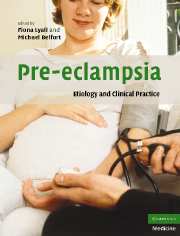Book contents
- Frontmatter
- Contents
- List of contributors
- Preface
- Part I Basic science
- 1 Trophoblast invasion in pre-eclampsia and other pregnancy disorders
- 2 Development of the utero-placental circulation: purported mechanisms for cytotrophoblast invasion in normal pregnancy and pre-eclampsia
- 3 In vitro models for studying pre-eclampsia
- 4 Endothelial factors
- 5 The renin–angiotensin system in pre-eclampsia
- 6 Immunological factors and placentation: implications for pre-eclampsia
- 7 Immunological factors and placentation: implications for pre-eclampsia
- 8 The role of oxidative stress in pre-eclampsia
- 9 Placental hypoxia, hyperoxia and ischemia–reperfusion injury in pre-eclampsia
- 10 Tenney–Parker changes and apoptotic versus necrotic shedding of trophoblast in normal pregnancy and pre-eclampsia
- 11 Dyslipidemia and pre-eclampsia
- 12 Pre-eclampsia a two-stage disorder: what is the linkage? Are there directed fetal/placental signals?
- 13 High altitude and pre-eclampsia
- 14 The use of mouse models to explore fetal–maternal interactions underlying pre-eclampsia
- 15 Prediction of pre-eclampsia
- 16 Long-term implications of pre-eclampsia for maternal health
- Part II Clinical Practice
- Subject index
- References
1 - Trophoblast invasion in pre-eclampsia and other pregnancy disorders
from Part I - Basic science
Published online by Cambridge University Press: 03 September 2009
- Frontmatter
- Contents
- List of contributors
- Preface
- Part I Basic science
- 1 Trophoblast invasion in pre-eclampsia and other pregnancy disorders
- 2 Development of the utero-placental circulation: purported mechanisms for cytotrophoblast invasion in normal pregnancy and pre-eclampsia
- 3 In vitro models for studying pre-eclampsia
- 4 Endothelial factors
- 5 The renin–angiotensin system in pre-eclampsia
- 6 Immunological factors and placentation: implications for pre-eclampsia
- 7 Immunological factors and placentation: implications for pre-eclampsia
- 8 The role of oxidative stress in pre-eclampsia
- 9 Placental hypoxia, hyperoxia and ischemia–reperfusion injury in pre-eclampsia
- 10 Tenney–Parker changes and apoptotic versus necrotic shedding of trophoblast in normal pregnancy and pre-eclampsia
- 11 Dyslipidemia and pre-eclampsia
- 12 Pre-eclampsia a two-stage disorder: what is the linkage? Are there directed fetal/placental signals?
- 13 High altitude and pre-eclampsia
- 14 The use of mouse models to explore fetal–maternal interactions underlying pre-eclampsia
- 15 Prediction of pre-eclampsia
- 16 Long-term implications of pre-eclampsia for maternal health
- Part II Clinical Practice
- Subject index
- References
Summary
Trophoblast invasion is a major feature of hemochorial placentation, notably in the human where this invasion is exceptionally deep compared with the few other primate species studied so far (Ramsey et al., 1976). It is assumed that pre-eclampsia/eclampsia, which occurs almost exclusively in the human species, is in some way associated with problems related to this deep invasion. So far, only a few case reports have been published suggesting a similar complication in pregnant gorillas (Baird, 1981; Thornton and Onwude, 1992). Unfortunately nothing is known about trophoblast invasion in this species.
It is now common knowledge that during pregnancy extensive vascular alterations take place in the spiral arteries which supply maternal blood to the placenta. In this chapter we will first sketch briefly the historical context of the discovery of structural changes in placental bed spiral arteries and the role of invading extravillous trophoblast. The importance of this “physiological change” of spiral arteries is highlighted by its restricted occurrence in pre-eclampsia, and therefore we will discuss next the evidence for impaired trophoblast invasion preceding the onset of clinical symptoms of pre-eclampsia. In the third part the structural features of invaded and non-invaded spiral arteries will be described in some detail, and finally we will evaluate the occurrence of physiological changes and vascular lesions in other disorders of pregnancy.
Impaired physiological change in spiral arteries
Although pre-eclampsia/eclampsia has been recognized for a long time in history as an important pregnancy complication (Lindheimer et al. 1999), a possible histopathological basis for this condition was only identified in the late 1960s.
- Type
- Chapter
- Information
- Pre-eclampsiaEtiology and Clinical Practice, pp. 3 - 19Publisher: Cambridge University PressPrint publication year: 2007
References
- 1
- Cited by



